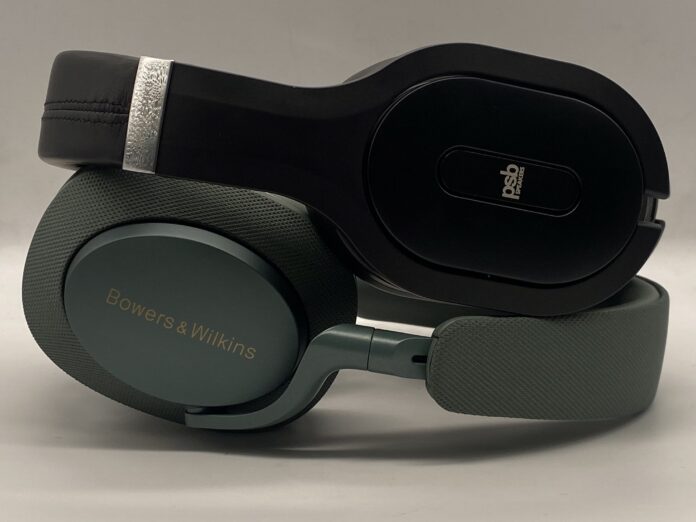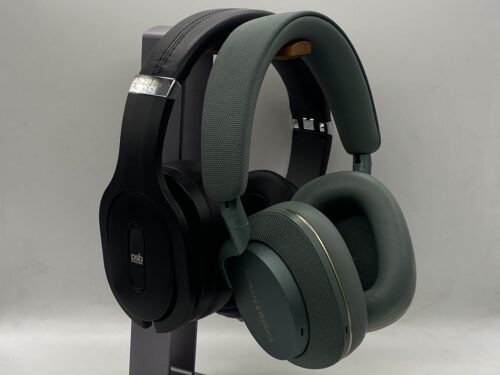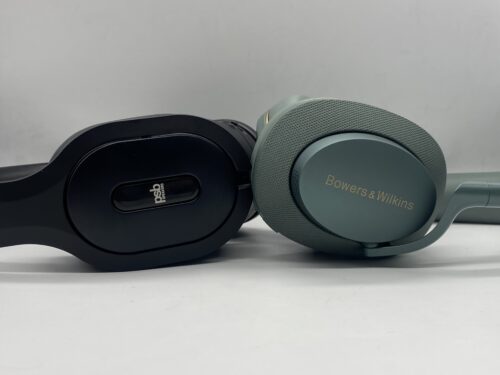For consumer wireless headphones there are a few different categories. You have true budget headphones that are anywhere below $200 and the more popular mainline headphones that cost around the $500 range. Popular headphones like the Bowers and Wilkins PX7 S2e would be one of the best examples, but can a cheaper headphone match up to it? The PSB M4U MK II has been a recent favorite of mine, and I would like to see how well these two headphones compare.
What You Get
| Bowers & Wilkins PX7 S2e | PSB M4U MK II |
|
|
Look & Feel
It’s very hard to beat B&W when it comes to aesthetics. The PX7 S2e just looks so classy sitting next to any pair of headphones, let alone the M4U. You get a lot more striking color variations on the S2e, with the forest green and ocean blue being two of my favorites. The M4U only has black and brown, but for them, it’s less about the aesthetic and more about the gyro-action ear pads. This is one of the only advantages the M4U has over the S2e in terms of design. You can achieve a good seal with more flexibility, but the S2e isn’t any less comfortable in comparison.
Design & Functionality
You’ll find both headphones use 40mm dynamic drivers, but they use different diaphragms and components. The PX7 S2e has a bio-cellulose diaphragm, while the M4U has an ABS + Polycarbonate housing. Neither set of headphones gets particularly loud, but the M4U gives you a bit more headroom to play with than the S2e. Both of these headphones feature noise-canceling, with the S2e being slightly stronger than the M4U. They also both have companion apps, but they’re very different from each other. The S2e is much more simplistic, while the M4U has “RoomFeel,” and a personalized EQ that requires a hearing test. In terms of functionality, the only feature I prefer on the S2e is the wear sensor that automatically activates play/pause when you take the headphones off and put them back on.
Bluetooth & Battery Life
Neither the M4U nor S2e features anything too out of the ordinary in terms of Bluetooth capabilities. They both offer different kinds of aptX CODECs and have fast connections. You won’t see anything crazy in terms of battery life either, with the S2e giving you only five more hours of playtime than the M4U.
Soundstage
Both of these headphones showcase similar abilities in their soundstage and imaging. Neither headphone will give you the greatest width, but their stereo fields are completely intact. Everything will sound like it’s happening inside your head, but both headphones do a good job of articulating space and localization. Comparing the two results in more similarities than differences, but I feel separation is better on the PX7 S2e. There’s more blank space for the sound to play with, however, the M4U might have better depth with its more decipherable layers. The PX7 S2e feels more like the complete stereo image, but the M4U goes a bit further with its non-linearity, adding a bit more dimension to the sound.
Low End
Their respective EQ settings strongly impact the bass section of these headphones. With their natural tuning, you won’t find them lacking impact. They both have a thick tone that feels meaty and satisfying. There is a great texture to both of their sound signatures, with the PX7 S2e featuring the most bloom. The M4U appears more direct in comparison, but they both have balance and accuracy too. You might not get as much of a significant lift from the M4U without EQ or the personal sound test, which is a characteristic that comes naturally to the PX7 S2e.
Mids
You’ll find more fullness in the midrange with the M4U than you will with the PX7 S2e. That’s not to say that the PX7 S2e doesn’t have anything resembling fidelity in the mids. The M4U just provides a lot more weight to the frequencies compared to the S2e, giving notes a lot more definition. With the S2e, the mids have minimal gain but still take a clear shape in the frequency response. Both headphones treat musicality with realism, doing vocal performances great justice.
Highs
If you’re not looking for a treble extension, avoid both of these headphones. Both the M4U and S2e have crisp high frequencies that have bright textures. I don’t mind this response, and both headphones treat their high-frequency content well. Everything is easy to digest, making the sparkling timbre more enjoyable to listen to. The S2e feels the smoothest of the two, while the M4U has the most energetic sizzle, but I don’t find either response very tame.
Summary
The PSB M4U MK II and the Bowers and Wilkins PX7 S2e have similar sound signatures but are ultimately two very different sets of headphones. With the M4U, you get a much more complicated headphone due to its features, and that can work for and against it. You may prefer the simpler design of the S2e, with its superior functionality, ANC, and build quality. However, when it comes to sound, what you may prefer becomes more complex. I think I prefer the depth of the M4U overall, but the S2e isn’t far behind.
The Bowers & Wilkins PX7 S2e and PSB M4U MK II are available at Audio46.
MAJORHIFI may receive commissions from retail offers.











